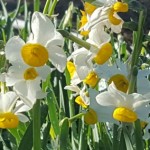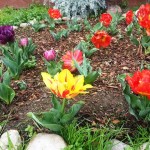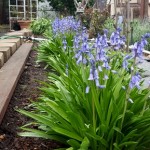Nature Dresses in Dramatic Colors for Spring
Many Northern California gardens are beginning to awaken in a riot of color from bulbs planted in the fall. Local gardeners will tell you that to achieve lots of color in a spring garden, you can’t beat blooming tulip, daffodil, hyacinth, allium, crocus, anemone, and ranunculus bulbs.
Buried in the earth, the bulbs are growing and sprouting and colonizing throughout winter. Many bulbs naturalize and spread year over year. One of my favorites is the deep blue Siberian Squill (Scilla siberica). The plant comes from the family of asperagaceae and thrives in Zones 2-8.
Bright green foliage appears first. Later, tight little buds open atop sturdy, straight stems. Each flower yields a bell-shaped bloom that is roughly one-half inch wide. It is only slightly fragrant. When established, three to five flowers form a stunning blue cluster on a six-inch stalk poking above sword-like foliage.
It’s best to plant these bulbs about six inches apart and three inches deep in early fall. Choose a spot in full sun or part shade. Siberian squill require medium amounts of water. For the greatest impact, do mass plantings under deciduous shrubs and trees or in circles or rows.

Masses of blooming daffodils provide a focus and cheery greeting in a bleak late winter or early spring garden
When planted near yellow daffodils, the rich blue color of the Siberian squill will really pop. These bulbs do not need to be lifted as they will naturalize and colonize over the years. And come spring each year, you will have dramatic color combinations sprouting all around your garden.
_________________________________________________
If you enjoy reading about gardening or farming topics, keeping chickens and bees, caring for fruit trees and vegetable gardens, or living well, check out my Henny Penny Farmette series of mysteries from Kensington Publishing and my health and wellness books from Adams Media/Simon and Schuster. The mysteries contain end-of-chapter tips on beekeeping and related topics. The rituals and meditation books feature tips and strategies for living your best peaceful life now.

More than 150 rituals for sound mind, strong body, and meaningful connections to the people around you
Certain Plants And Chickens Don’t Go Together
Chickens are curious creatures. Spend a hour watching them scratch, poke, and peck and you’ll see what I mean.
I’ve never lost a free-range chicken because of something it ate; but it seems as though they’ll eat anything. It got me thinking that a variety of plants commonly grown in landscapes and backyard gardens could make chickens ill if they ate the berries, nuts, or leaves of those plants.
The following represents a small sampling of common plants that could make your feathered friends sick or even poison them.
- Acorn
- Alfalfa
- Azalea
- Daffodil
- Eggplant
- Foxglove
- Hemlock
- Jasmine
- Jimson Weed
- Lamb’s Quarters
- Lantana
- Milkweed
- Nicotiana (tobacco)
- Oleander
- Oxalis
- Poison Ivy
- Poison Oak
- Pokeweed
- Pyracantha
- Red Maple
- Rhubarb
- Sweet Pea
- Tulip
- Wild Onion
- Wisteria
Chickens are foraging birds and have good natural instincts. They will taste a plant and if something isn’t right, they’ll likely leave it. If you allow them to forage for themselves in pasture, more often than not, they’ll eschew the poisonous plants in your garden or landscape for the rich diversity of what they find in open pastureland.
 Facebook
Facebook Goodreads
Goodreads LinkedIn
LinkedIn Meera Lester
Meera Lester Twitter
Twitter










